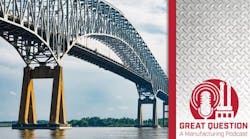Josh Fisher is editor in chief of FleetOwner, and he covers everything from modern commercial fleet management to operational efficiency, autonomous trucking, and emerging transportation technology. Rod Sutton is the editorial lead of Construction Equipment, which focuses on helping managers of heavy equipment and trucks improve their performance. Anna Smith is the news editor for IndustryWeek, and she reports on a host of supply chain issues. Nicole Stempak is managing editor of EHS Today and keeps an eye on health and safety issues happening throughout the industry. Ryan Curtiss is digital editor for Roads & Bridges, which reports on the road and bridge construction industry in North America. These industry professionals recently spoke with IndustryWeek editor in chief Robert Schoenberger about the March 26 collapse of Baltimore's Francis Scott Key Bridge and how this tragic incident will impact industry from a multitude of different angles.
Below is an excerpt from the podcast:
IW: Let's talk a little bit more about the business impact of this. One of the big questions we have is on supply chains. Anna, you've written a lot about the fact that global shipping is a little snarled right now, between problems with the low water in the Panama Canal and the challenges getting shipments through the Red Sea with the attacks on shipping there. Where does this fit into all that now? Now we have yet another challenge facing the shipping industry.
AS: So, it's kind of fitting into this overall narrative I'm seeing now that a regular, stable supply chain is something that doesn't really exist anymore. Specifically for Baltimore, it’s one of the ten largest ports in the U.S. in terms of dollar value of the cargo. Obviously, everyone's heard it's going to have an impact mostly on the auto industry. It's the number one port in the U.S. for automobile imports and exports.
See also: With AI, the time is now, say manufacturing technologists, futurist, 'evangelist'
Also on the vehicle side, they handle a lot of farm and construction machinery and equipment. Then, on a different side which might cause some ripple effects, it handles things from the food industry, like sugar, that can have, like I said, ripple effects upstream. Also, aluminum and other types of metals that go through there are going to have another ripple effects for metals manufacturing or anything from home building.
Also on the home building side, there are different materials like plaster, plywood, things like that, that are going to disrupt any kind of construction. So home construction and building construction are going to have a similar constraint to the auto industry that might not be talked about as much.
One thing I have seen is conversations about the spillover that's going to happen in the nearby East Coast ports. There are concerns about overflow or too much constraint trying to find alternate ports. What I have found, though, is they're mostly diverting to three ports. They're diverting to Norfolk, New York, and Wilmington, and those ports, actually, will be able to sort of lessen the impact. They have a much larger volume that they can handle.
See also: Maximum security? How multifactor authentication is being defeated
So overall, what I'm seeing from the experts is they actually expect the impact on the supply chain to be pretty minimal long term. And any short-term impacts are going to have to do with mostly the logistics, particularly in Baltimore, but also on the East Coast and any sort of upstream things in the Midwest mostly.
And like I said, the lesson to be learned from this from the supply chain, as I've seen many people discuss, is the importance of having redundancies, whether that's safety or in your supply chain, and being prepared because, like I said, we’re never going to go back. It seems like a new normal where there's never going to be a time when everything's just running smoothly.
IW: I wanted to talk to you, Josh. Ignoring the port itself, this is a major bridge. This is a major corridor across one of the busiest sections in the country. How are shippers, how are trucking companies dealing with this challenge?
JF: It really is. It typically handles nearly 5,000 trucks a day, and millions of vehicles a year travel that span over the river. It's part of the Baltimore Beltway. And what's happened now is there are three other ways to get across the harbor, but two of them are tunnels, and there is another bridge. The tunnels all limit the size of the trucks that can travel through them, and particularly any carrying any sort of hazardous material such as petroleum or gases cannot travel through the bridge.
Podcast: Accessing data and clearer paths to drive your digital transformation
Jeremy Wolfe, who's part of FleetOwner, spoke to the head of the Maryland Motor Carriers Association, who noted one of his members said it added about another hour or two to their commute. It's a 30-mile detour, basically, if you don't go through the tunnels. But you also have to think of all the other cars and regular travelers who also are detouring around that span that no longer exists. So that's added a lot more time, and it's really become a big local trucking problem in Maryland and around Baltimore.
In speaking to some other folks within the industry, we have seen spot rates go up. Those are the rates that truckers can bid on individually and fleets can bid on individually to carry loads.
So, we've seen a big spike in spot rates out of Baltimore, but a lot of analysts feel like, to echo what Anna was talking about, it won't have the same sort of widespread supply chain problems that we certainly saw out of the ports of Long Beach and Los Angeles during the COVID days.
But it's a big headache for people in the Baltimore area and could affect a lot of jobs, too, around the port because a lot of the drivers rely on carrying loads out of the port of Baltimore, along with there's a lot of workers in that area right now.
Podcast: How AI, cybersecurity, and sustainability are impacting asset management
IW: I've been through those tunnels, and what always struck me was the $6 fee that you get when you go through the Baltimore Tunnel, and it's usually connecting to another toll road. So that's a very expensive corridor, and that's for consumer drivers. I imagine the truckers pay a much higher fee, if they're allowed to use that tunnel at all.
JF: The ones that are small enough do, and it's generally a per-axle fee. I'm not positive on that. I've been through it too. I live about 50 miles or so from the bridge. I think some people living within the area, Robert, might think that $6 is one of the cheaper tolls that you pay along the I-95 corridor.




